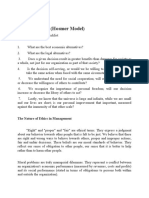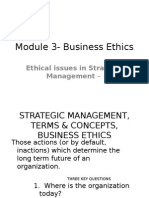Ethical Dilemmas
Ethical Dilemmas
Uploaded by
Tasmia ThalilCopyright:
Available Formats
Ethical Dilemmas
Ethical Dilemmas
Uploaded by
Tasmia ThalilCopyright
Available Formats
Share this document
Did you find this document useful?
Is this content inappropriate?
Copyright:
Available Formats
Ethical Dilemmas
Ethical Dilemmas
Uploaded by
Tasmia ThalilCopyright:
Available Formats
Ethical Dilemmas, Sources and their resolutions:
What is an ethical dilemma?
An ethical dilemma is a moral situation in which a choice has to be made between two
equally undesirable alternatives. Dilemmas may arise out of various sources of behavior or
attitude, as for instance, it may arise out of failure of personal character, conflict of personal
values and organizational goals, organizational goals versus social values, etc. A production
manager, when asked to produce a commodity by his company may face an ethical
dilemma, when he knows that it will harm the large number of consumers who buys and
uses the same.
Sources of ethical problems:
According to Keith Davis and William C Fredrick ethical challenges in business take several
forms and raise different kinds of ethical dilemmas. Ethical challenges and their attendant
dilemmas may arise due to (i) Failure of personal character (ii) Conflict of personal values
and organizational goals (iii) Organizational goals versus social values and (iv) Personal
beliefs vs. organizational practices (v)Hazardous, but popular products.
Other Ethical Challenges
Some of the sample practices are:
1. Price fixing and profiteering due to monopoly and often artificially created scarcity.
2. Shifting unfair shares to the producer, stakeholders & employees.
3. Discriminatory wage structure
4. Using up scarce and irreplenishable industrial resources and raw materials
5. Shifting or locating business at the cost of society
6. Overworking women and children.
Why Business should act ethically?
The reasons for an organization to be ethical include:
• To protect its own interest,
• To protect the interests of the business community as a whole so that the public will
have trust in it.
• To keep its commitment to society to act ethically,
• To meet stakeholder expectations.
• To prevent harm to the general public,
• To build trust with key stakeholder groups,
• To protect themselves from abuse from unethical employees and competitors,
• To protect their own reputations,
• To protect their own employees, and
• To create an environment in which workers can act in ways consistent with their
values.
How Corporations Observe Ethics to reduce dilemmas?
• Publish in-house codes of ethics to be strictly followed by all their associates
• Employ people with a reputation for high standards of ethical behavior at the top
levels
• Incorporate consideration of ethics into performance reviews.
• Give rewards for ethical behavior.
• Conduct an Ethics Audit
Code of personal ethics for employees:
Most company codes list the following values that are expected from their employees:
1. Respect confidential information to which you have access.
2. Maintain high standard of professional responsibility
3. Avoid being placed in situations involving conflict of interest
4. Act with integrity
5. Do not discriminate against anybody or anything on any bias
6. Maintain professional relations based on mutual respect for individuals and
organizations
7. Be committed to the goals of the organization
8. Do not give up your individual professional ethics.
How to create an ethical working environment?
1. Make the decision to commit to ethics
2. Recognize that you are a role model by definition, by your action, and by your values.
3. Assume the responsibility for instilling ethical behavior
4. Articulate your values
5. Train the staff in ethical behavior
6. Encourage open communication
7. Be consistent
8. Abide by laws of the land.
How does a company establish ethical standards?
-Most companies in advanced countries and some even in developing countries have
developed their own codes of conduct which provide some ethical standards for their
employees.
-It should be emphasized here that it is not enough for a company to merely have the codes
of ethics, but these should be effectively communicated to employees so that they are
aware of them and abide by them.
-The effectiveness of the exercise, of course, will depend on how serious the top
management is in implementing them, and the good example they set in observing them.
-Think and reflect about yourself, about the management, about the people, and about the
relationship and the values you wish to incorporate.
How to resolve ethical dilemmas?
There are two basic approaches in resolving ethical dilemmas: deontological (action
oriented) and teleological (result oriented).
A co-worker may feign ignorance if the management makes a big fuss about the loss of
worthless scrap of asbestos when he or she knows that one of his or her colleagues has
taken them to provide roof material for inhabitants of several hutments who otherwise
would suffer when it rained cats of dogs. It may produce more good than harm. Likewise, a
person may steal a loaf of bread to feed a group of hungry children. A deontological
approach to either of these cases will still condemn (disapprove) these acts.
Teleological approach to ethics takes a pragmatic, commonsense, not professional approach
to ethics. According to this school of thought, “The moral character of actions depends on
the simple, practical matter of the extent to which actions actually help or hurt people.
Actions that produce more benefits than harms are “right”; those that don’t are “wrong”. A
teleological approach to the above mentioned examples will tend to condone (allow) those
acts of charity.
The center for ethics and business offers “a brief, three step strategy” in which both the
deontological and teleological approaches converge. The strategy is as follows:
Step 1: Analyze the consequences
Step 2: Analyze the actions
Step 3: Make a decision.
You might also like
- Ehical Issues in International Business2Document32 pagesEhical Issues in International Business2Sharma ShikhaNo ratings yet
- Chapter Ethical Dilemma NovDocument19 pagesChapter Ethical Dilemma NovRitu BansodeNo ratings yet
- BPSMDocument23 pagesBPSMsunny12101986No ratings yet
- Week 3 Q3 Business EthicsDocument7 pagesWeek 3 Q3 Business EthicsCristine SilvaNo ratings yet
- Business Ethics CH-3Document5 pagesBusiness Ethics CH-3Tokib TowfiqNo ratings yet
- Socsci108 Module 3Document7 pagesSocsci108 Module 3xyriellelouvallienteNo ratings yet
- 6: Practice of Ethics in BusinessDocument14 pages6: Practice of Ethics in Businesshelalahmed777No ratings yet
- DilemmasDocument18 pagesDilemmasIshika PalNo ratings yet
- Chapter 1Document6 pagesChapter 1Ir VingNo ratings yet
- Be Week 3Document5 pagesBe Week 3CLARISE LAURELNo ratings yet
- CH 3 Ethical DilemmaDocument23 pagesCH 3 Ethical DilemmaSahil ParmarNo ratings yet
- BPE PPT Pro Ethics UNIT 6Document42 pagesBPE PPT Pro Ethics UNIT 6znsg8xcs2qNo ratings yet
- Business Ethics Week 3-4 Final XXDocument14 pagesBusiness Ethics Week 3-4 Final XXLeinel Macutay MalazzabNo ratings yet
- Chapter 2.docx SMALLDocument9 pagesChapter 2.docx SMALLعبيدة محاميدNo ratings yet
- Itb CHP 2Document29 pagesItb CHP 2mburhankhan16No ratings yet
- Business Ethics and Law-181207051841Document53 pagesBusiness Ethics and Law-181207051841Eng MatanaNo ratings yet
- Cfi4107 Module Unit Four Managing EthicsDocument52 pagesCfi4107 Module Unit Four Managing Ethicszanelentombezinhle2211No ratings yet
- Ethics in ManagemnetDocument20 pagesEthics in Managemnetvishal mangwaniNo ratings yet
- Unit 4: Business Ethics Concept of Business EthicsDocument6 pagesUnit 4: Business Ethics Concept of Business EthicspisabandmutNo ratings yet
- Business Ethics and Social RDocument90 pagesBusiness Ethics and Social RJaatoo100% (2)
- Business Ethics and Social ResponsibilityDocument16 pagesBusiness Ethics and Social Responsibilitytitan abcdNo ratings yet
- Business EthicsDocument39 pagesBusiness EthicsKhaled AlhowaimelNo ratings yet
- 6: Practice of Ethics in BusinessDocument14 pages6: Practice of Ethics in Businessmithun4243No ratings yet
- Ethics in The Workplace Supplemental Self Study PresentationDocument51 pagesEthics in The Workplace Supplemental Self Study PresentationAbdullah Al MamunNo ratings yet
- 1.definition of Business EthicsDocument8 pages1.definition of Business EthicsMAHENDRA SHIVAJI DHENAK100% (1)
- Chapt 1 Introduction To EthicsDocument24 pagesChapt 1 Introduction To EthicsAdam Zachary Mohd FaizalNo ratings yet
- Ethics Analysis (Hosmer Model) : The Nature of Ethics in ManagementDocument10 pagesEthics Analysis (Hosmer Model) : The Nature of Ethics in ManagementIshita RanaNo ratings yet
- Lecture 3. Ethical DilemmaDocument14 pagesLecture 3. Ethical DilemmaTinselpolecat 14No ratings yet
- Module 6.business EthicsDocument12 pagesModule 6.business EthicsShreeshaila P VijayapurNo ratings yet
- Chapter 2Document21 pagesChapter 2Sag-e-AttarNo ratings yet
- Sale Marketing ForeceDocument38 pagesSale Marketing ForeceSubham .MNo ratings yet
- Chapter 10 Business EthicsDocument6 pagesChapter 10 Business Ethicsabhiramikunnath02No ratings yet
- Ethics 2 ModuleDocument52 pagesEthics 2 ModulerajirithuNo ratings yet
- Lesson 2 NOTES Business Ethics An OverviewDocument3 pagesLesson 2 NOTES Business Ethics An OverviewSafh SalazarNo ratings yet
- Chap 5Document9 pagesChap 5Lan AnhNo ratings yet
- Business Ethics Q3-W3-6Document29 pagesBusiness Ethics Q3-W3-6Luis Dominic A. CrisostomoNo ratings yet
- Bee Eth.3........Document7 pagesBee Eth.3........Ratikant ParidaNo ratings yet
- Ethical Dilemma, Sources and Their Resolutions: Session 4Document34 pagesEthical Dilemma, Sources and Their Resolutions: Session 4Vamsi KrishnaNo ratings yet
- Sbaa 1503Document82 pagesSbaa 1503Rammohanreddy RajidiNo ratings yet
- Unit IDocument21 pagesUnit Ikush mandaliaNo ratings yet
- Business Ethics & CSR BookDocument82 pagesBusiness Ethics & CSR BookZaid Bin SafdarNo ratings yet
- Business Ethics (Module - 1)Document21 pagesBusiness Ethics (Module - 1)smritijaiswal575No ratings yet
- Ethics and Business: Suyanto, PHD., Ca Faculty of Economics and BusinessDocument37 pagesEthics and Business: Suyanto, PHD., Ca Faculty of Economics and BusinessAndiAgungBawonoNo ratings yet
- Business Ethics and Corporate Governance Module No 1Document67 pagesBusiness Ethics and Corporate Governance Module No 1Vanshita Malviya100% (1)
- Business Ethics Lec 4Document16 pagesBusiness Ethics Lec 4nailaNo ratings yet
- MSDM1 - Pertemuan 2Document19 pagesMSDM1 - Pertemuan 2Irfan YankNo ratings yet
- Business EthicsDocument20 pagesBusiness Ethicsaviannaryeee26No ratings yet
- 8: Practice of Ethics in BusinessDocument20 pages8: Practice of Ethics in Businessmithun4243No ratings yet
- Business Ethics and Social ResponsibilityDocument11 pagesBusiness Ethics and Social Responsibilitygamej8158No ratings yet
- Business EthicsDocument21 pagesBusiness EthicsMarlaNo ratings yet
- CSU MBA 6301 Unit I-Study GuideDocument2 pagesCSU MBA 6301 Unit I-Study GuideNicole BaxterNo ratings yet
- Topic 1 - Introduction To Business Ethics (Week 1)Document10 pagesTopic 1 - Introduction To Business Ethics (Week 1)Pei JuanNo ratings yet
- Module 3Document5 pagesModule 3luppy ccNo ratings yet
- Unit 2Document29 pagesUnit 2Parth BhattNo ratings yet
- Business Ethics-ReviewerDocument18 pagesBusiness Ethics-ReviewerAngelu PanganibanNo ratings yet
- Module 2 Business Ethics On GovercoDocument24 pagesModule 2 Business Ethics On Govercojade shimNo ratings yet
- BSR NoteDocument14 pagesBSR Noteashkar299No ratings yet
- Ethical and Professional Practices: An Overview of EthicsDocument7 pagesEthical and Professional Practices: An Overview of EthicshalfaiaNo ratings yet
- Business EthicsDocument22 pagesBusiness Ethicssimply_coool100% (3)
- DK Essential Managers: Ethical Business: Sustainability, Commitment, Values, Transparency, EnvironmentFrom EverandDK Essential Managers: Ethical Business: Sustainability, Commitment, Values, Transparency, EnvironmentNo ratings yet
- DJJ40132 Engineering and Society Chapter 3Document48 pagesDJJ40132 Engineering and Society Chapter 3Nurzatul Alia AzriNo ratings yet
- Gee1 Activity-4Document1 pageGee1 Activity-4Kai SubidoNo ratings yet
- Finals YarnDocument7 pagesFinals YarnAngelo BarcelonaNo ratings yet
- Chapter 7 TCWDocument25 pagesChapter 7 TCWkleoNo ratings yet
- Philosophical Ethics: Extracts, Encapsulations, and EvaluationsDocument80 pagesPhilosophical Ethics: Extracts, Encapsulations, and EvaluationsYevi JeagerNo ratings yet
- Kidnapped, The Ethics of Paying RansomDocument14 pagesKidnapped, The Ethics of Paying RansomTehreem KhizraNo ratings yet
- CSR Module 2Document54 pagesCSR Module 2TusharNo ratings yet
- 25년 영독 영어본문Document55 pages25년 영독 영어본문pickdoremiNo ratings yet
- End AssgnDocument8 pagesEnd AssgnJemima KimaniNo ratings yet
- Bbm4201 Ethics and Social Responsibility Edt Final NotesDocument185 pagesBbm4201 Ethics and Social Responsibility Edt Final Notesabuliham236No ratings yet
- Philosophy - 2nd QuarterDocument21 pagesPhilosophy - 2nd QuartercariagamarcusjoaquinNo ratings yet
- 2022 PSY3041 Week 1 EthicsDocument63 pages2022 PSY3041 Week 1 Ethicsvybn2gmm4yNo ratings yet
- Moral Case Analysis On The Rights of PDLsDocument5 pagesMoral Case Analysis On The Rights of PDLskissleaffhecka.justoNo ratings yet
- Ethics ModuleDocument80 pagesEthics ModuleMARIA MICHELLE A. HELARNo ratings yet
- Frameworks and Principles Behind Our Moral Disposition: Study Guide For Module No. 4Document13 pagesFrameworks and Principles Behind Our Moral Disposition: Study Guide For Module No. 4JOHN PATRICK GARCIANo ratings yet
- MGP 2023 Cohort 5 Half Length Test 19 SolutionDocument13 pagesMGP 2023 Cohort 5 Half Length Test 19 SolutionKumudNo ratings yet
- Group6 Introductin Tophilosophy, Ethic and Rwandan CultureDocument9 pagesGroup6 Introductin Tophilosophy, Ethic and Rwandan Culturemoniyonshuti2No ratings yet
- Ethics Book PDFDocument22 pagesEthics Book PDFvitarudrapatiNo ratings yet
- Ethics in Science CommunicationDocument28 pagesEthics in Science CommunicationChamaraNo ratings yet
- Application of Deontology Ethics Theory in AccountingDocument2 pagesApplication of Deontology Ethics Theory in AccountingNis DancelNo ratings yet
- Philo 10-EthicsDocument22 pagesPhilo 10-EthicsJolina SilatNo ratings yet
- Conditional Deontology MARK JUSTINE S. SALENDocument23 pagesConditional Deontology MARK JUSTINE S. SALENLira GonzalesNo ratings yet
- 05 Stanwick & Stanwick (2021) - Absolute Essential of Business EthicsDocument123 pages05 Stanwick & Stanwick (2021) - Absolute Essential of Business EthicsMd Tapan MahmudNo ratings yet
- Ethics ReviewerDocument8 pagesEthics ReviewerChrista Felicia AldayNo ratings yet
- Colegio de Dagupan Arellano Street, Dagupan City School of Business and AccountancyDocument24 pagesColegio de Dagupan Arellano Street, Dagupan City School of Business and AccountancyKurt dela TorreNo ratings yet
- Chapter 4 Deontology Part 1Document20 pagesChapter 4 Deontology Part 1Shermaigne Ananayo BuyaNo ratings yet
- 1 - NUM1205 - An Introduction To Law and Ethics - SVDocument41 pages1 - NUM1205 - An Introduction To Law and Ethics - SVLuis Martin PunayNo ratings yet
- Chapter - 5Document7 pagesChapter - 5Aljun MorilloNo ratings yet
- Bayking, Meirteod, GEN SCI BDocument4 pagesBayking, Meirteod, GEN SCI BAntonio VallejosNo ratings yet
- Ethics - WikipediaDocument253 pagesEthics - Wikipediatabanpatrick7No ratings yet

























































































